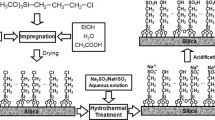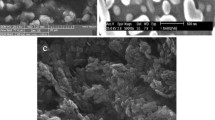Abstract
Methanesulfonic acid (MSA) was successfully immobilized in silica, leading to a novel and environmentally friendly solid acid catalyst SMSA. The most important feature of SMSA is that anhydrous formic acid is used to hydrolysis of tetraethylorthosilicate (TEOS). No water was added in the whole preparation. Therefore, MSA could be anchored in silica matrix more effectively instead of being dissolved in water. This new organic/inorganic hybrid catalyst was characterized by powder X-ray diffraction (XRD), energy dispersive spectrum (EDS), N2 adsorption-desorption analyzer, thermogravimetric analysis (TGA-DSC) and pyridine-FTIR. The catalytic activity was tested by alkylation of olefins and aromatics. High concentration acid sites, both Lewis and Brønsted, abundant porosity and large surface area enabled the highest activity for SMSA, among MCM-22, ZSM-5 and industrial acidity clay.
Similar content being viewed by others
References
Khaligh NG, Shirini F. J Mol Catal A-Chem, 2011, 348: 20–29
Ronchin L, Vavasori A, Toniolo L. J Mol Catal A-Chem, 2012, 355: 134–141
Gal YS, Jin SH, Park JW, Lim KT. J Ind Eng Chem, 2011, 17: 282–286
Jang HS, Kim YH, Kim YO, Lee SM, Kim JW, Chung WJ, Lee YS. J Ind Eng Chem, 2014, 20: 29–36
Jeong K, Chung WY, Kye YS, Kim D. J Ind Eng Chem, 2011, 17: 427–429
Gernon MD, Wu M, Buszta T, Janney P. Green Chem, 1999, 3: 127–140
Tian Y, Meng X, Duan JY, Shi L. Ind Eng Chem Res, 2012, 51: 13627–13631
Long XL, Wang ZH, Wu SQ, Wu SM, Lv HF, Yuan WK. J Ind Eng Chem, 2014, 20: 100–107
Sabour B, Peyrovi MH, Hamoule T, Rashidzadeh M. J Ind Eng Chem, 2014, 20: 222–227
Hua D, Li P, Wu Y, Chen Y, Yang M, Dang J, Xie Q, Liu J, Sun XY. J Ind Eng Chem, 2013, 19: 1395–1399
Kim DW, Kim CW, Koh JC, Park DW. J Ind Eng Chem, 2010, 16: 474–478
Cheetham AK, Rao CNR, Feller RK. Chem Commun, 2006: 4780–4795
Hoffmann F, Cornelius M, Morell J, Froeba M. Angew Chem Int Ed, 2006, 45: 3216–3251
Schubert U. Chem Soc Rev, 2011, 40: 575–582
Lin Z, Huang L, Ling Q, Chen H, Zhao C. J Mol Catal A-Chem, 2012, 365: 73–79
Allen HC, Raymond EA, Richmond GL. J Phys Chem A, 2011, 105: 1649–1655
Shen G, Horgan A, Levicky R. Colloid Surface B, 2004, 35: 59–65
Givan A, Loewenschuss A, Nielsen CJ. J Mol Struct, 2005, 748: 77–90
Givan A, Loewenschuss A, Nielsen CJ. J Phys Chem A, 2000, 104: 3441–3445
Nguyen C, Sonwane CG, Bhatia SK, Do DD. Langmuir, 1998, 14: 4950–4952
Beck JS, Vartuli JC, Roth WJ, Leonowicz ME, Kresge CT, Schmitt KD, Chu CTW, Olson DH, Sheppard EW. J Am Chem Soc, 1992, 114: 10834–10843
Gorsd M, Pizzio L, Blanco M. Appl Catal A-Gen, 2011, 400: 91–98
Vejayakumaran P, Rahman IA, Sipaut CS, Ismail J, Chee CK. J Colloid Interf Sci, 2008, 328: 81–91
Kalita P, Gupta NM, Kumar R. J Catal, 2007, 245: 338–347
Vinh-Thang H, Huang Q, Ungureanu A, Eic M, Trong-On D, Kaliaguine S. Micropor Mesopor Mat, 2006, 92: 117–128
Joshi J, Mishra MK, Srinivasarao M. Can J Chem, 2011, 89: 663–670
Pârvulescu AN, Gagea BC, Pârvulescu V, Pârvulescu VI, Poncelet G, Grange P. Catal Today, 2002, 73: 177–185
Pârvulescu AN, Gagea BC, Poncelet G, Pârvulescu VI. Appl Catal A-Gen, 2006, 301: 133–137
de Angelis A, Flego C, Ingallina P, Montanari L, Clerici MG, Carati C, Perego C. Catal Today, 2001, 65: 363–371
Author information
Authors and Affiliations
Corresponding author
Rights and permissions
About this article
Cite this article
Liu, N., Yao, J. & Shi, L. A novel method to anchor methanesulfonic acid in silica matrix. Sci. China Chem. 59, 370–379 (2016). https://doi.org/10.1007/s11426-015-5506-7
Received:
Accepted:
Published:
Issue Date:
DOI: https://doi.org/10.1007/s11426-015-5506-7




